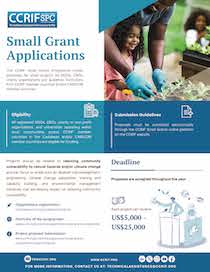This event briefing describes the impact of rainfall in Trinidad and Tobago, which was associated with a Covered Area Rainfall Event (CARE), starting on 22 September and ending on 24 September 2022. The Rainfall Index Loss (RIL) was below the attachment point of Trinidad and Tobago’s excess rainfall policy for Tobago and therefore no payout is due.
This event briefing describes the impact of rainfall in the Turks and Caicos Islands, which was associated with a Covered Area Rainfall Event (CARE), starting on 20 September and ending on 22 September 2022. The Rainfall Index Loss (RIL) was below the attachment point of the Turks and Caicos Islands’ excess rainfall policy and therefore no payout is due.
Hurricane Fiona was the sixth named tropical cyclone of the 2022 Atlantic Hurricane Season. On 20 September, Fiona made landfall on the Turks and Caicos Islands as a major hurricane, with hurricane-force winds affecting this country and the nearby islands of The Bahamas South-East. 1Moreover, tropical-storm-force winds also affected Haiti. At the time of writing this report, Fiona was heading for the western North Atlantic Ocean.
Tropical Cyclone Ian was the eighth named tropical cyclone and the fourth hurricane of the 2022 Atlantic Hurricane Season. On 26 September, Hurricane Ian passed near the Cayman Islands, spreading tropical-storm-force winds over this country for several hours. At the time of writing this report, Ian had made landfall in Florida as a major hurricane and was moving toward the Atlantic Ocean.
This event briefing describes the impact of rainfall in Saint Kitts and Nevis, which was associated with a Covered Area Rainfall Event (CARE), starting on 17 September and ending on 19 September 2022. The Rainfall Index Loss (RIL) was below the attachment point of Saint Kitts and Nevis’ excess rainfall policy and therefore no payout is due.
This event briefing describes the impact of rainfall in the British Virgin Islands, which was associated with a Covered Area Rainfall Event (CARE), starting on 18 September and ending on 20 September 2022. The Rainfall Index Loss (RIL) was below the attachment point of the British Virgin Islands’ excess rainfall policy and therefore no payout is due.
This event briefing describes the impact of rainfall in Dominica, which was associated with a Covered Area Rainfall Event (CARE), starting on 17 September and ending on 19 September 2022. The Rainfall Index Loss (RIL) was below the attachment point of Dominica’s excess rainfall policy and therefore no payout is due.
This event briefing describes the impact of rainfall in Antigua and Barbuda, which was associated with a Covered Area Rainfall Event (CARE), starting on 17 September and ending on 19 September 2022. The Rainfall Index Loss (RIL) was above the attachment point of Antigua and Barbuda’s excess rainfall policy and a payout of US$420,645.00 is due.
A magnitude 5.3 earthquake occurred at 08:44:35 (UTC) on 14 September 2022, 46.5 km (28.9 mi) ENE of Jiquilillo, Nicaragua; 71.6 km (44.5 mi) E of Corinto, Nicaragua and 73 km (45.4 mi) E of El Viejo, Nicaragua. Initial estimates from the United States Geological Survey (USGS) located the epicentre of the event at 12.547°N, 87.828°W, and at a depth of 69.3 km (43.06 mi).
Tropical Storm Fiona was the sixth named tropical cyclone of the 2022 Atlantic Hurricane Season. On 16 and 17 September, Fiona passed over the Northern Leeward Islands. In particular, tropical-storm-force winds spread over Antigua and Barbuda, Montserrat and Saint Kitts and Nevis.





